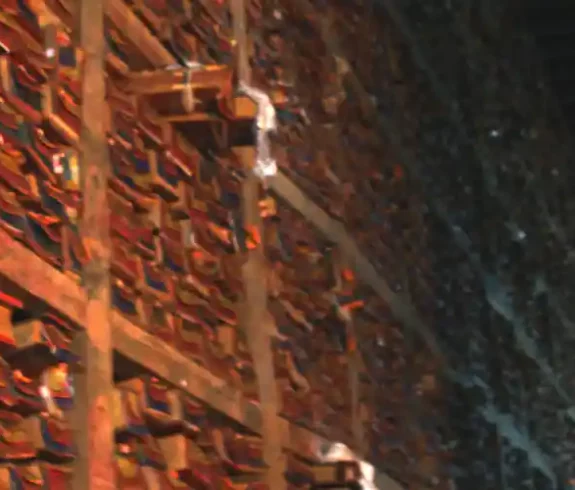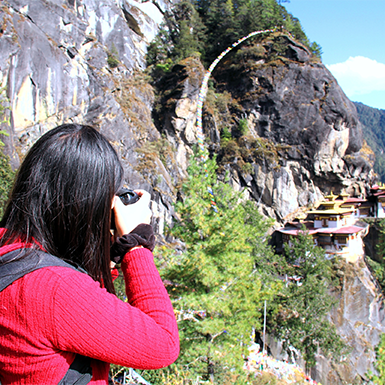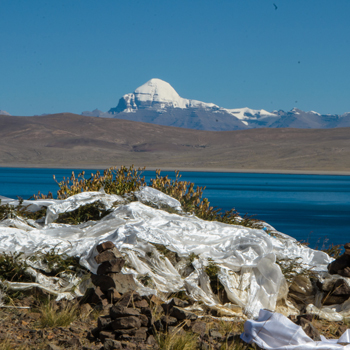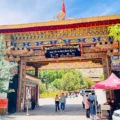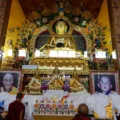Nestled amidst the majestic Himalayas lies the Sakya Monastery, a crown jewel of Tibetan Buddhism. The monastery, founded in 1073, has become renowned for its architectural splendor and its unparalleled collection of ancient wisdom in the Sakya Monastery Library. This extraordinary library stands as a testament to the unwavering dedication of Buddhist scholars for centuries, meticulously safeguarding a vast repository of knowledge.
The Sakya Library is more than just a collection of books; it’s a vibrant center of learning and a vital cornerstone of Buddhist heritage. Within its walls lie countless treasures, including the Kangyur and Tengyur, the foundational pillars of the Tibetan Buddhist canon. These monumental works encompass the teachings of the Buddha himself, along with commentaries by esteemed scholars. The library extends far beyond religious texts, boasting a wealth of secular literature encompassing history, philosophy, astronomy, and medicine.
The Sakya monastery library, found in 2003 within the monastery walls, unveiled a hidden gem—a trove of 84,000 manuscripts. This remarkable discovery included scriptures adorned with gold lettering and intricate illustrations, some exceeding six feet in length. Among these is a heavyweight champion—a scripture weighing over 500 kilograms, solidifying its place as the world’s heaviest book.

A Legacy Etched in Parchment: The Historical Tapestry of Sakya Monastery Library
The Sakya Monastery Library is more than a collection of ancient texts; it’s a chronicle of the Sakya school of Tibetan Buddhism. The monastery, founded in 1073, arose from a humble cave dwelling that Khön Könchog Gyalpo established. This visionary leader recognized the importance of preserving Buddhist knowledge and laid the groundwork for the library’s future grandeur.
From Humble Beginnings to Grand Repository
- They established it alongside the monastery in 1073.
- Khön Könchog Gyalpo, the founder, prioritized knowledge preservation.
- The library grew with the monastery, becoming a center of learning.
The Sakya Lineage and the Flourishing Library
- The Sakya school, known for its scholarly tradition, actively contributed to the collection.
- Monks meticulously copied and acquired manuscripts on various subjects.
- The library became a treasure trove, solidifying the monastery’s reputation as a leading Buddhist center.
The Sakya School’s Rise and the Library’s Significance
- The Sakya school emphasized logic and debate and played an important role in Tibetan history.
- During the 13th and 14th centuries, Sakya lamas even held political power.
- The Sakya Monastery Tibet Library served as a vital resource for these leaders.
Facing Challenges and Enduring Legacy
- The library faced challenges during the Cultural Revolution.
- Despite hardships, the monks’ resilience and the values of the texts ensured their survival.
- Today, the Sakya Monastery Library remains a cornerstone of the Sakya tradition, attracting scholars and preserving its rich heritage.
The Heart of the Collection: Buddhist Scriptures
- Kangyur and Tengyur: These foundational pillars of the Tibetan Buddhist canon are revered in the library. The Kangyur contains the recorded words of the Buddha himself, while the Tengyur presents commentaries by esteemed scholars.
- Rare and Ancient Texts: The library safeguards a wealth of rare and ancient Buddhist scriptures, some dating back centuries. These precious manuscripts offer invaluable insights into the early development of Tibetan Buddhist thought and practice.
Beyond Religious Texts: A Tapestry of Knowledge
While Buddhist scriptures form the collection’s core, the Sakya Monastery Library extends far beyond religious texts. The library houses various secular works, reflecting the breadth of intellectual inquiry fostered within the monastery walls.
- Historical Chronicles: These manuscripts meticulously document Tibet’s political and social landscape throughout history, providing a rich tapestry of the region’s past.
- Philosophical Treatises: The library is brimful of philosophical works exploring diverse schools of thought, including logic, epistemology, and ethics.
- Scientific and Medical Texts: Manuscripts delve into subjects like astronomy, mathematics, and medicine, showcasing the multifaceted nature of Tibetan scholarship.
Illuminating the Collection: Artistic Gems
The Sakya Monastery Tibet Library isn’t just a repository of knowledge; it’s also a haven for artistic expression. The collection features:
- Illuminated Manuscripts: These exquisite manuscripts feature intricate illustrations and calligraphy, transforming the written word into a visual feast.
- Artworks by Renowned Masters: Paintings and sculptures by revered Tibetan artists adorn the library walls, adding an aesthetic dimension to the intellectual richness.

A Haven for Knowledge: Unveiling the Architecture of the Sakya Monastery Library
Nestled within the larger monastery complex, the library boasts a unique design tailored to preserve its precious holdings.
A Blend of Functionality and Beauty
The library’s architectural style reflects a harmonious blend of Tibetan and Chinese influences. Thick, load-bearing walls provide structural stability, while smaller windows minimize exposure to harsh sunlight and temperature fluctuations, crucial factors for safeguarding delicate manuscripts.
Designed for Preservation
Several unique features contribute to the library’s functionality as a long-term storage facility for texts:
- Multi-Storied Layout: The library is likely multi-storied, with each level potentially dedicated to a specific type of text or collection. This organizational system ensures efficient access and retrieval of materials.
- Ventilation System: A well-designed ventilation system is likely to control humidity levels and prevent mold growth, a significant threat to paper-based materials.
- Limited Light Exposure: Small windows and strategically placed walls minimize direct sunlight exposure, which can cause fading and brittleness in manuscripts.
A Secure Sanctuary
The Sakya Monastery Library likely incorporates security measures to protect its treasures. These may include:
- Reinforced Doors: Thick wooden doors with sturdy locks would have deterred theft or damage.
- Limited Access: Access to the library may have been restricted to authorized personnel, further safeguarding the collection.
A Legacy in Stone
The architectural design of the Sakya Monastery Tibet Library reflects the deep respect the Sakya tradition holds for knowledge and its preservation. Every element, from the sturdy walls to the controlled lighting, creates a haven for these irreplaceable treasures.
Safeguarding the Past: Preservation Efforts at the Sakya Monastery Library
The Sakya Library houses an invaluable collection of Tibetan Buddhist texts, some centuries old. Preserving these fragile treasures requires constant vigilance and combining traditional and modern techniques.
Time-Tested Methods
For generations, the monks of the Sakya Monastery have employed time-tested methods to safeguard their collection:
- Natural Ventilation: The library’s architecture likely incorporates a natural ventilation system to control humidity levels. This measure helps prevent mold growth, which poses a significant threat to paper-based materials.
- Limited Light Exposure: Small windows and strategically placed walls minimize direct sunlight exposure. It reduces the risk of fading and brittleness in the manuscripts.
- Physical Maintenance: Monks traditionally turn the pages of the manuscripts regularly to prevent them from sticking together and to air them out.
Modern Interventions
The need to ensure the long-term survival of the collection necessitates modern interventions as well:
- Environmental Monitoring: Modern technology can monitor temperature and humidity levels within the library, allowing adjustments to create a more stable environment for the texts.
- Conservation Techniques: Specialists in paper conservation may employ techniques to repair damaged manuscripts and prevent further deterioration.
- Digitization Project: A digitization project is underway to create digital copies of the collection. This approach not only safeguards the original documents but also makes the library’s knowledge accessible to a broader audience.
International Collaboration
The Sakya Monastery Library collection is recognized internationally. Collaborations with international organizations dedicated to heritage preservation can support these efforts. This support can come in the form of:
- Funding: Financial assistance can help purchase necessary conservation materials and equipment.
- Expertise: International organizations may offer expertise in conservation techniques and best practices.
- Training: Training programs for monks and library staff on proper handling and care of the manuscripts can be invaluable.
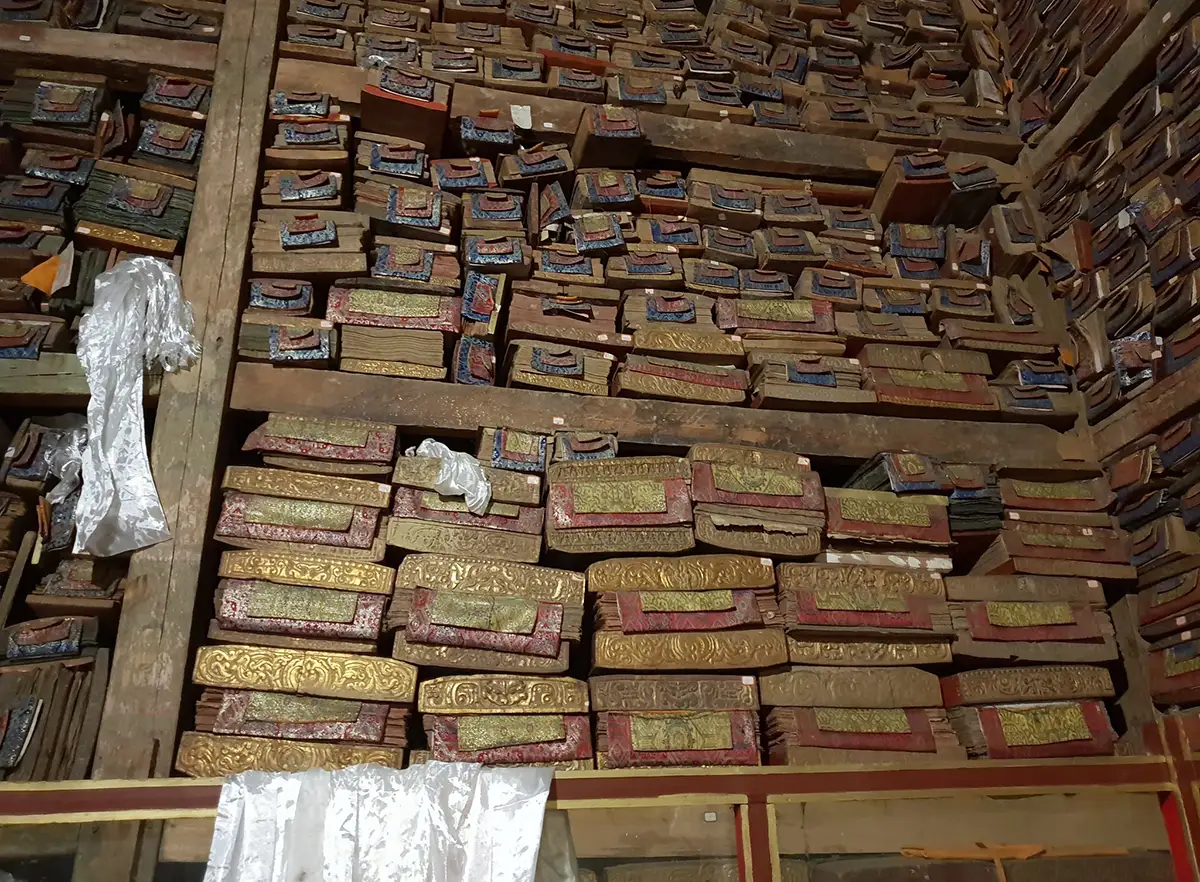
Unveiling Knowledge: Access and Research at the Sakya Monastery Library
The Sakya Monastery Library is immensely important for scholars and researchers of Tibetan Buddhism. However, due to the fragility of the collection and the monastery’s active role as a place of worship, access to the general public is limited.
Navigating Access
Obtaining access to the Sakya Library requires planning and adherence to specific protocols:
- Formal Application: Scholars must submit an application outlining their research goals and the required materials.
- Affiliation: Affiliation with a recognized academic institution or established Buddhist center strengthens an application.
- Restricted Access: Even with approval, the library may limit access to certain sections or specific texts.
A Beacon for Buddhist Studies
The Sakya Monastery Library is vital in contemporary Buddhist studies despite the restrictions. Here’s why:
- Unmatched Collection: The library boasts a vast and unique collection of manuscripts unavailable elsewhere. It allows researchers to explore lesser-known aspects of the Sakya tradition and Tibetan Buddhism in general.
- Preserved History: The library’s collection directly links to the Sakya school’s historical development and Tibetan Buddhist thought. Studying these texts provides invaluable insights into the past.
- Source Material for New Discoveries: The Library’s funds stimulate new research and discovery. Scholars can analyze previously unseen texts, potentially leading to groundbreaking advancements in our understanding of Tibetan Buddhism.
Global Significance
The Sakya Monastery Library transcends its physical location. Its significance extends to scholars worldwide:
- International Collaboration: The library’s ongoing digitization project allows international researchers to access digital copies of the collection, fostering collaboration and knowledge exchange.
- Preserving Intangible Heritage: The library safeguards Tibetan Buddhism’s intangible heritage, ensuring that this tradition’s knowledge and wisdom endure for future generations.
- A Bridge Between Cultures: The Sakya Monastery Library is a cross-cultural bridge, providing a window into the rich wisdom and spiritual tradition of Tibetan Buddhism.
Challenges and Opportunities
The Sakya Monastery Library attests to the ongoing human search for knowledge, but it has various problems in the modern world. Knowing these hurdles will guarantee the library’s continued existence and ensure that people seeking Buddhist knowledge can access it.
Challenges to Consider
- Environmental Threats: Fluctuating temperatures, humidity, and exposure to sunlight can damage delicate manuscripts. The library might require ongoing maintenance and climate control systems to mitigate these threats.
- Funding Issues: Preserving a collection of this magnitude requires significant resources. The monastery might depend on donations, grants, or partnerships to fund proper conservation efforts and technological advancements.
- Political Constraints: The library’s location and political climate might limit access and collaboration efforts. Open communication and international partnerships can help overcome these obstacles.
A Future Steeped in Knowledge
Despite the challenges, the future of the Sakya Monastery Library appears bright. Several initiatives hold immense promise for safeguarding and disseminating its knowledge:
- Continued Digitalization: The ongoing digitization project (Sakya Monastery digital library) offers a secure and accessible way to preserve the collection and share it with a broader audience.
- Expansion and Collaboration: Partnerships with international organizations can provide expertise, funding, and technology for further preservation efforts and potential expansion of the digital archive.
- A Beacon for Global Buddhist Education: By making the library’s resources more accessible, the Sakya Library can become a vital resource for scholars and students worldwide, fostering a deeper understanding of Tibetan Buddhism and its profound impact on global religious traditions.
The Enduring Legacy: A Final Look at the Sakya Monastery Library
The Sakya Monastery Library is like a woven fabric from centuries, where it is alive with learning, faith, and human search for knowledge that has no end. It represents the deep traditions within the Tibetan religion.
A Wellspring of Cultural Heritage
- The library safeguards a treasure trove of manuscripts, including religious texts and works on history, philosophy, and science. These irreplaceable materials offer a window into Tibet’s intellectual and cultural landscape throughout the ages.
- The artistic heritage is equally impressive, with illuminated manuscripts and artwork by revered Tibetan masters adding another cultural significance to the library.
A Beacon for Buddhist Education
- The Sakya Monastery Tibet Library houses foundational Buddhist scriptures like the Kangyur and Tengyur, providing a wellspring of knowledge for monks and scholars alike.
- Rare and ancient texts offer invaluable insights into the early development of Tibetan Buddhist thought, enriching our understanding of this influential tradition.
- The ongoing digitization project (Sakya Monastery digital library) ensures more comprehensive access to this wealth of knowledge, fostering a deeper appreciation for Tibetan Buddhism on a global scale.
A Legacy for the Future
The Sakya Monastery Library is a testament to the enduring power of knowledge preservation. The monks’ dedication and modern advancements in conservation and digitalization ensure that this invaluable collection continues to inspire and educate future generations.
